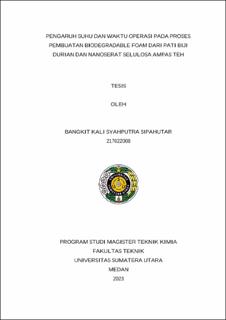| dc.description.abstract | This study aims to examine the effect of temperature and operating time in the baking process on the characteristics of biodegradable foam (biofoam) products filled with tea waste nanofiber including the physical and mechanical properties of the biofoam produced. The method used in the manufacture of biofoam is the baking process. In this study, the synthesis of cellulose nanofibers (NSS) from tea waste was carried out by several steps, namely delignification, bleaching, hydrolysis with sulfuric acid and ultrasonication which were then characterized. The NSS from tea waste obtained was then used as filler material in biofoam. Biofoam was made from a mixture of durian seed starch and polyvinyl alcohol as a matrix, and mixed with NSS from tea waste as a filler with baking operation time conditions of 60 minutes; 80 minutes and 120 minutes for each operating temperature of 70 oC, 80 oC, 90 oC, 100 oC, and 110 oC. The molded biofoam was then tested for physical and mechanical properties and characteristics. The results of characterization of tea waste fiber and NSS from tea waste using Fourier Transform Infra-Red can be seen that there is not much change in compound content after experiencing size reduction. The result of characterization of NSS from tea waste with an average particle length of 76.28 nm and have a rodlike shape. The effect of temperature variation and baking process operating time can affect the physical and mechanical strength values of biofoam. The highest tensile strength value of biofoam is 0.26 MPa under conditions of 100 oC and 120 minutes with a commercial national standard minimum value of 0.1 MPa. The lowest percentage of water absorption, moisture content, and density values were 56.05%, 3.25% and 0.91 g/cm3 respectively at 110 oC temperature and 120 minutes with commercial standard maximum values of 7,14%, 1,11% and 0,05 g/cm3 respectively. The highest mass loss percentage of biofoam was 76.81% at 100 oC and 120 minutes which degraded within 35 days with a commercial international value of 0% at 180 days of degradation. The results of Scanning Electron Microscope analysis of biofoam show that in the condition of 100 oC and 120 minutes, the fracture surface is smooth and the fillers are dispersed quite evenly with a clear difference with the comparison at 70 oC and 120 minutes, the fracture surface is not smooth and there are empty spaces due to the uneven distribution of the constituent materials | en_US |





